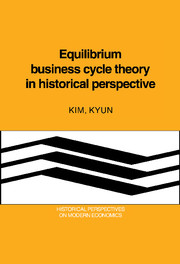Book contents
- Frontmatter
- Contents
- Acknowledgments
- 1 Introduction: equilibrium business cycle theory
- 2 The classical tradition and business cycle theory
- 3 The econometric approach to business cycles
- 4 Hayek, the Cowles Commission, and equilibrium business cycle theory
- 5 Contemporary trends in macroeconometrics
- 6 Conclusion
- References
- Index
2 - The classical tradition and business cycle theory
Published online by Cambridge University Press: 23 March 2010
- Frontmatter
- Contents
- Acknowledgments
- 1 Introduction: equilibrium business cycle theory
- 2 The classical tradition and business cycle theory
- 3 The econometric approach to business cycles
- 4 Hayek, the Cowles Commission, and equilibrium business cycle theory
- 5 Contemporary trends in macroeconometrics
- 6 Conclusion
- References
- Index
Summary
Although the phenomenon of the business cycle was recognized in the early nineteenth century, it was not an independent subject of study. It was neglected by most classical economists, and business cycle analysis was continued largely by economic writers outside the classical tradition, especially in the nineteenth century.
The turn of the century, however, gave way to a different phase of cycle studies. A seeming contradiction between classical theory and the cycle phenomenon began to be recognized; rather serious efforts to incorporate the business cycle into equilibrium followed. Hayek (1933, 1935) is a leading example of an economist who made this effort. Hayek's theory, as it turned out, was an unsuccessful competitor of Keynesian economics, which had replaced classical theory; nonetheless, Hayek's business cycle theory deserves credit in that it was the first systematic attempt to include the phenomena of business cycles in the territory of classical economics. In other words, his cycle theory was different not only from classical theory, which regarded the business cycle as an unimportant temporary phenomenon, but also from Keynesian economics, which in fact left behind classical thinking and asked a fundamentally different set of questions, having chiefly to do with unemployment.
In this chapter, the main concern is the attempt by interwar business cycle theorists to incorporate business cycles into classical equilibrium economics. This seems especially important once one takes account of the fact that the recent equilibrium business cycle theory is claimed to be a successor of interwar cycle theories. The chapter comprises three sections. The first deals with business cycle theories in the nineteenth century.
Information
- Type
- Chapter
- Information
- Publisher: Cambridge University PressPrint publication year: 1988
